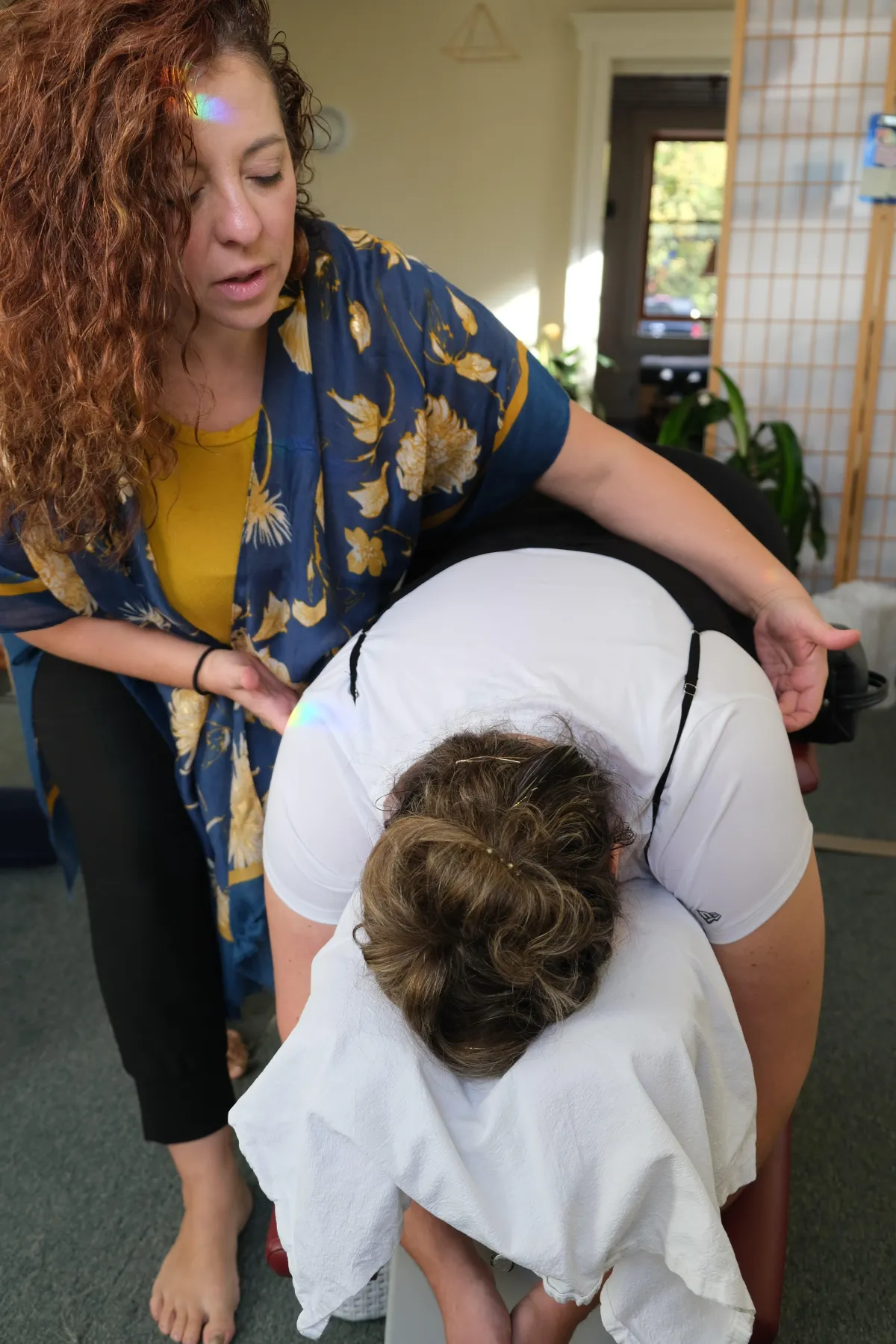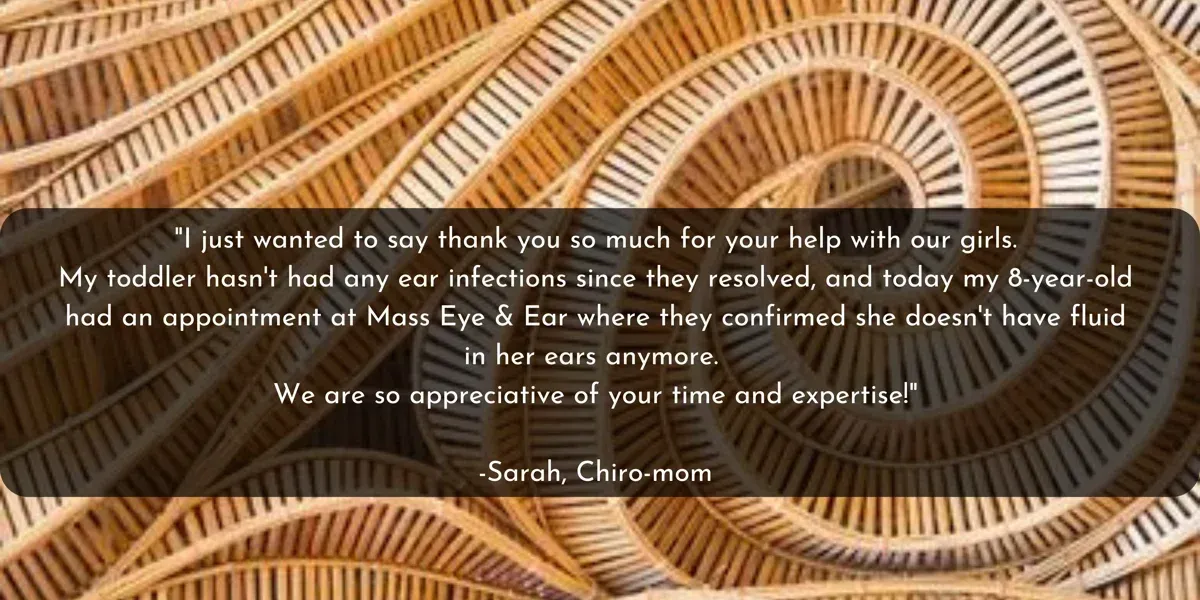


Holistic Chiropractic, Massage & Hypnosis in Hanover, MA


Family Chiropractic
Realign, restore, reorganize. With a safe and gentle, yet comprehensive approach suited for the whole family, to address physical health, we combine modern science with ancient wisdom to honor your body as an interconnected whole.

Perinatal Care
Perinatal chiropractic care supports a healthier and more comfortable pregnancy by relieving back pain, optimizing pelvic alignment, and preparing the body for an easier labor and delivery.
Our Services


Orthopedic Body Work
Orthopedic massage is a targeted form of bodywork that focuses on the soft tissues surrounding joints to relieve pain, improve mobility, and restore proper function from injury or chronic conditions

Hypnosis
Achieve emotional and mental harmony. Learn techniques that help manage stress, cultivate positivity, and foster a resilient mindset.

Our Specialties
Perinatal Chiropractic
Our perinatal chiropractic care services are specifically designed to support pre-conceiving, expecting, and post-partum mothers throughout their journey. Chiropractic adjustments to optimize the alignment of the spine, pelvis, and nervous system, ensuring a healthy and comfortable pregnancy. Dr Penny's experience and training range from aiding with alleviating the common pregnancy discomforts, to addressing more complex functional and nutritional concerns. With our gentle and safe approach, we aim to provide holistic care that promotes the well-being of both the mother and baby.
Pediatric Chiropractic
Our pediatric chiropractic care services are specifically designed to support children and youth of all ages with a special emphasis on the first two years of life. With our gentle and safe approach, we aim to provide holistic care that promotes the well-being from infants to adolescents. Our commitment to families is to help children and teens thrive in health, achieve all their milestones with ease, perform in sports with ease, and have an optimal advantage in life.
Orthopedic Massage
At Whole Being Healing, our orthopedic massage services are tailored
to address musculoskeletal conditions and promote overall wellness. Our skilled massage therapist combines various techniques including deep tissue massage, trigger point therapy, and myofascial release to target specific areas of pain and tension. Whether you are recovering from an injury, managing chronic pain, or simply seeking relaxation, our orthopedic massage can help alleviate discomfort and improve your physical well-being. Each session is customized to meet your unique needs and goals, ensuring a personalized and effective treatment experience.
Hypnosis
Experience the transformative power of hypnotherapy at Whole Being Healing. Our certified hypnotherapist offers a safe and supportive environment for exploring the subconscious mind and initiating positive change. Through deep relaxation and focused attention, hypnotherapy can help you overcome various challenges such as anxiety, phobias, smoking cessation, weight management, and more. By tapping into the power of your subconscious, you can unlock your inner potential and achieve lasting transformation. Our hypnotherapy sessions are tailored to your specific goals and desires, empowering you to create positive shifts in your life and enhance your overall well-being.
Bio Geometric Integration (B.G.I)
BGI was discovered and developed by Sue Brown, DC. It is a specialized approach of chiropractic care, performed by licensed Doctors of Chiropractic, that is based upon a geometric model of the body, and incorporates concepts of
tensegrity, biodynamics, and force dynamics,
to allow Chiropractors to work with the body as an integrated whole, refining the adjustment, and increasing the overall effectiveness. It is a way to honor where the patterns of adaptation in the body come from, and understanding how to help the nervous system to integrate them. Additional information can be found on the website of BGI headquarters: What is BGI?
Craniopathy
The bones of the skull and the membranes and fluids within it have a tensegrity and rhythmic motion--a "cranial rhythmic impulse." Which is essential for proper cerebrospinal fluid (CSF) flow. Any restriction or imbalance in it could intervene with the CSF function and lead to a variety of health concerns, including headaches, ear canal narrowing, sinus issues, neck pain, jaw problems (TMJ), and even systemic issues. We use gentle, hands-on techniques to detect and correct these perceived imbalances. Important for all grown-ups and crucial for little ones, with an emphasis on the first two years of life. You can learn more in the book "It's All in the Head" by Drs Watson and Rosen
Our Services
Perinatal Chiropractic
Our perinatal chiropractic care services are specifically designed to support expecting mothers throughout their pregnancy journey. Our experienced chiropractors are trained in techniques that help alleviate common pregnancy discomforts such as back pain, pelvic pain, and sciatica. We believe in the power of chiropractic adjustments to optimize the alignment of the spine, pelvis, and nervous system, ensuring a healthy and comfortable pregnancy. With our gentle and safe approach, we aim to provide holistic care that promotes the well-being of both the mother and baby.
Pediatric Chiropractic
Our pediatric chiropractic care services are specifically designed to support children of all ages with a special emphasis on the first two years of life. Our commitment to families is to help children thrive in health and achieve all their milestones with ease. With our gentle and safe approach, we aim to provide holistic care that promotes the well-being from infants to adolescents.
Bio Geometric Integration (B.G.I)
BGI was discovered and developed by Sue Brown, DC. It is a specialized approach of chiropractic care, performed by licensed Doctors of Chiropractic, that is based upon a geometric model of the body, and incorporates concepts of
tensegrity, biodynamics, and force dynamics,
to allow Chiropractors to work with the body as an integrated whole, refining the adjustment, and increasing the overall effectiveness. It is a way to honor where the patterns of adaptation in the body come from, and understanding how to help the nervous system to integrate them. Additional information can be found on the website of BGI headquarters: What is BGI?
Orthopedic Massage
At Whole Being Healing, our orthopedic massage services are tailored to address musculoskeletal conditions and promote overall wellness. Our skilled massage therapist combines various techniques including deep tissue massage, trigger point therapy, and myofascial release to target specific areas of pain and tension. Whether you are recovering from an injury, managing chronic pain, or simply seeking relaxation, our orthopedic massage can help alleviate discomfort and improve your physical well-being. Each session is customized to meet your unique needs and goals, ensuring a personalized and effective treatment experience.
Hypnosis
Experience the transformative power of hypnotherapy at Whole Being Healing. Our certified hypnotherapist offers a safe and supportive environment for exploring the subconscious mind and initiating positive change. Through deep relaxation and focused attention, hypnotherapy can help you overcome various challenges such as anxiety, phobias, smoking cessation, weight management, and more. By tapping into the power of your subconscious, you can unlock your inner potential and achieve lasting transformation. Our hypnotherapy sessions are tailored to your specific goals and desires, empowering you to create positive shifts in your life and enhance your overall well-being.
From our Community
"Excellent, relaxing. I feel like I have a path forward and am not blocked by my inner thoughts and feelings. I’m motivated and in action. That is the way I feel right after a massage or hypnosis session with Jean-Pierre, or after a chiropractic adjustment with Dr. Penny. JP’s voice is soothing, he is calming and reassuring. I felt in control and safe at all times. I love mixing up my sessions between both of them. What a treat to work with them as part of my healing team."

-Shari S., hypnosis, massage and chiropractic participant
"JP has been my (massage) therapist for three years. He comes highly recommended due to his extensive training and professionalism. He’s helped me recover from injury and provided relaxation each week from my stressful job. He’s a great person with healing capabilities. Try his services. You will not regret it.”

-Sava B. Massage therapy client.
"I just wanted to say thank you so much for your help with our girls.
My toddler hasn't had any ear infections since they resolved, and today my 8-year-old had an appointment at Mass Eye & Ear where they confirmed she doesn't have fluid in her ears anymore.
We are so appreciative of your time and expertise!"

-Sarah, Chiro-mom
Hypnosis has been very helpful for me. Not only did I learn a very effective meditation, Jean-Pierre helped me reset my old patterns so that I can create ones that served me in my life much better."

-F.D.R., hypnosis client
From our Community
Our Team

Dr. Penny Aviles
Dr. Penny Aviles was born and raised in Mexico City, Mexico. She found her calling while living in Atlanta, GA. . She found herself one day unable to drive her car home due to a "mysterious" injury. She walked into the closest chiropractic office and waited until they could see her. That first visit changed the course of her life completely. During her last 2 years
at Agnes Scott College she noticed her health transform significantly thanks to chiropractic care. After graduating as an artist and working for the Museum of Contemporary Art of Georgia she
was inspired to become a chiropractor. She completed her Doctorate of Chiropractic at Life University in 2015.

Jean-Pierre Nakhoul
Jean-Pierre has been an orthopedic massage therapist for 12 years, graduating from Cortiva Institute of Massage in 2013 with additional certification in Orthopedic Massage. I also hold bachelor’s degrees in Psychology and East Asian Studies from NYU. My background includes over 20 years of dedicated meditation and martial arts practice, including four years as a disciple of a Shaolin Chan Buddhist monk. After college, he studied tai chi in China for two years and then traveled through India and Thailand for several months.
Our sun Diego

Our favorite employee, you might see him around playing with the beanie babies, quietly watching his favorite educational video or running around in the parking lot. He is the "why" behind everything that we do. All the recommendations for care are also tried on him. Ok, maybe he is our little guinea pig.
All jokes aside, we believe he is a great example of what a chiro-child is all about and the inspiration we have to help people become the best version of themselves by reconnecting to their source. Most than anything, he is WBH's favorite mascot.
The Team



Dr. Penny Aviles
Jean-Pierre Nakhoul
Our sun Diego
Dr. Penny Aviles was born and raised in Mexico City, Mexico. She found her calling while living in Atlanta, GA. She found herself one day unable to drive her car home due to a "mysterious" leg pain. She walked into the closest chiropractic office and waited until they could see her. That first visit changed the course of her life completely. During her last 2 years at Agnes Scott College she noticed her health transform significantly thanks to chiropractic care. After graduating as an artist and working for the Museum of Contemporary Art of Georgia she was inspired to become a chiropractor. She completed her Doctorate of Chiropractic at Life University in 2015.
With a lifelong interest and passion for physical, mental, and emotional health and wellbeing, Jean-Pierre brings a holistic and deeply experienced approach to his practice. He has been an orthopedic massage therapist for 12 years, graduating from Cortiva Institute of Massage in 2013 with additional certification in Orthopedic Massage. He is also a certified hypnotherapist specializing in pain and stress relief techniques with an associates degree from the Hypnosis Motivation Institute, the only accredited school of hypnotherapy in the county. He holds a bachelor’s degree in Psychology and East Asian Studies from NYU. His background includes over 20 years of dedicated meditation and martial arts practice, including four years as a disciple of a Shaolin Chan Buddhist monk. After college, he studied tai chi in China for two years and then traveled through India and Thailand for several months learning from various meditation and martial arts teachers.
Our favorite employee, you might see him around playing "chiropractic vet" with the beanie babies, quietly watching his favorite educational video or running around in the parking lot. He is the "why" behind everything that we do. All the recommendations for care are also tried on him. Ok, maybe he is our little guinea pig.
All jokes aside, we believe he is a great example of what a chiro-child is all about and the inspiration we have to help people become the best version of themselves by reconnecting to their source. Most than anything, he is WBH's favorite mascot.
Frequently Asked Questions
What if I have specific symptoms and health concerns?
We all express manifestations of dis-ease somehow in our system. The various symptoms of stress, from headaches to nerve entrapments, lack of sleep to digestive discomfort, aches and pains to muscle tension, etc. look different for everyone. But instead of just treating those symptoms, our approach tackles the root cause. We focus on helping your body release, integrate the tension it's holding, and regain ease, so you can feel wonderful and find lasting stress-adaptation and relief.
What can I expect from the first visit?
Your first visit will give us an idea of what your concerns are and how to address them better. We will talk about your unique health goals and what you've been through. If you're coming for...
Chiropractic: the first visit lasts 45-60 minutes. Dr. Penny will be thorough in her evaluation. If necessary she will refer you for x-rays. She will explain how chiropractic can help you and you will receive your first adjustment if necessary and will help you book your Report of Findings appointment where she will cover her recommendations for care and you can opt in for care and get adjusted again on that same visit.
Massage: the first visit lasts 60 or 90 minutes, depending on your choice. Jean-Pierre will listen to your specific concerns and will perform any specific muscle tests if necessary. He will be gentle, detailed and effective giving you a "pain free deep tissue" session (a one-of-a-kind in the South Shore and Boston area). He prefers to focus on one area of concern per session to give you the best results.
Hypnosis: the first session lasts 60-75 minutes. Jean-Pierre will learn about you through a detailed conversation with you and will practice an first hypnosis with you to determine how you respond better to it. We recommend you book a minimum of 3 sessions for best results. Ask us about the Initial Hypnosis Trio to save when you prepay them in advance.
Do you accept insurance?
Due to the nature of our practice, we cannot directly bill your insurance. We will, however, provide you with a receipt that you can submit for reimbursement. We've found this to ultimately be the most cost-effective option for our clients, and we'll be happy to explain why at your visit.
How do I prepare for a session?
Wear comfortable clothing, preferably no belts or jewelry, and come prepared to discuss your health history and wellness goals.
Can I participate in your services if I have no prior experience?
Absolutely! Our services are designed to accommodate all levels of experience. We provide personalized guidance to ensure everyone can participate comfortably and safely.

Email us: [email protected]
Call us: (781) 908-0821
720 Washington Suite, Hanover, MA, 02339
© 2025 Whole Being Healing - All Rights Reserved. Cultivating holistic health through natural and sustainable practices for a balanced and harmonious life.









